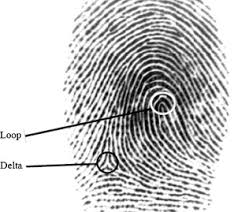FOR 100 Exam II: Fingerprints and Biometrics
1/29
There's no tags or description
Looks like no tags are added yet.
Name | Mastery | Learn | Test | Matching | Spaced |
|---|
No study sessions yet.
30 Terms
What are fingerprints?
Fingerprints are a reproduction of friction skin ridges.
Does a fingerprint change as you age?
No, it stays the same your whole life.
How can you classify fingerprints?
Fingerprints have general ridge patterns which can help them become systematically classified.
Who figured out how many fingerprints were in the world?
Galton; 64 billion
What are the three classes of fingerprints?
Loops, arches, whorls
How many people are in the fingerprint classes?
60-65% loops, 30-35% whorls, 5% arches
What’s the criteria for a loop?
A loop must have one or more ridges entering from one side of the print, recurving, and exiting from the same side.
What’s the difference between and ulnar or radial loop?
If the loop opens toward the little finger, it is called an ulnar loop. If the loop opens toward the thumb, it is called a radial loop.
What must all loops have?
A delta.

What are the four groups of whorls?
Plain, central pocket loop, double loop, accidental.
What do all whorls have?
Type lines and two deltas.
What are the two types of arches?
Plain (wider arch) and tented (skinnier arch).
What is ACE-V and what does it stand for?
A four-step process to identify and individualize a fingerprint.
-Analysis: Identify points of comparison
-Comparison: Compare print at 3 levels (min)
-Evaluation: Identification (inconclusive v conclusive)
-Verification: Confirmed by another examiner
How many groups can all the fingerprint cards in the world fall into?
1024
What is the basis for the determination of the primary classification?
The presence or absence of a whorl pattern
What percent of the world falls into a 1/1 classification? (no whorls)
25%
What data does AFIS contain?
Ridge endings and their transformation into bifurcations.
What are latent prints?
Invisible to the eye. (think on a book)
What are visible prints?
Duh, visible prints. When the print comes in contact with blood, ink, etc.
What are plastic prints?
Ridge impressions left on plastic, dust, or wax.
What’s the difference between prints on a porous v. non-porous material?
Latent prints on non-porous surfaces (glass, tile, etc.) can be picked up with powder, while prints on porous surfaces (paper, cardboard, cloth) need chemical treatment.
What are other methods of finding latent prints on non-porous surfaces?
-Fuming chamber 6 hours: can reveal prints on metal, electric tape, leather, etc.
-Handheld wand that heats up a small cartridge filled with cyanoacrylate
What are chemicals used for finding latent prints on porous surfaces?
-Iodine fuming: Heats iodine to cause vapors that combine with prints making them visible
-Ninhydrin: Reacts with amino acids in prints to make a purple-blue color
-Physical Developer: Silver-nitrate based, used on prints that were once wet
What’s the difference between physiological biometrics and behavioral biometrics?
Physiological: Fingerprints, handprints, iris, retina, & facial scans
Behavioral: Handwriting, voice, keystroke
What are the main functions of biometrics?
Matching & verification and access control
How many different prints does the NGI (next generation identification) have?
73 million fingerprints, 8.1 million mugshots, 5.7 million palmprints, 8,500 iris scans
Are iris’ unique to every person?
Yes. The muscle patterns and iris construction are unique. The template of the iris is called an IrisCode
Are iris biometrics invasive?
No, not invasive. They remain unchanged through life and replaced retina biometrics
What is the NPPS?
The FBI’s National Palm Print System. It contains a database of millions of palm prints.
What is FACE?
Facial Analysis, Comparison, and Evaluation. It contains civil photos from state and fed gov bases, like visa applicant photos and some state drivers license photos.